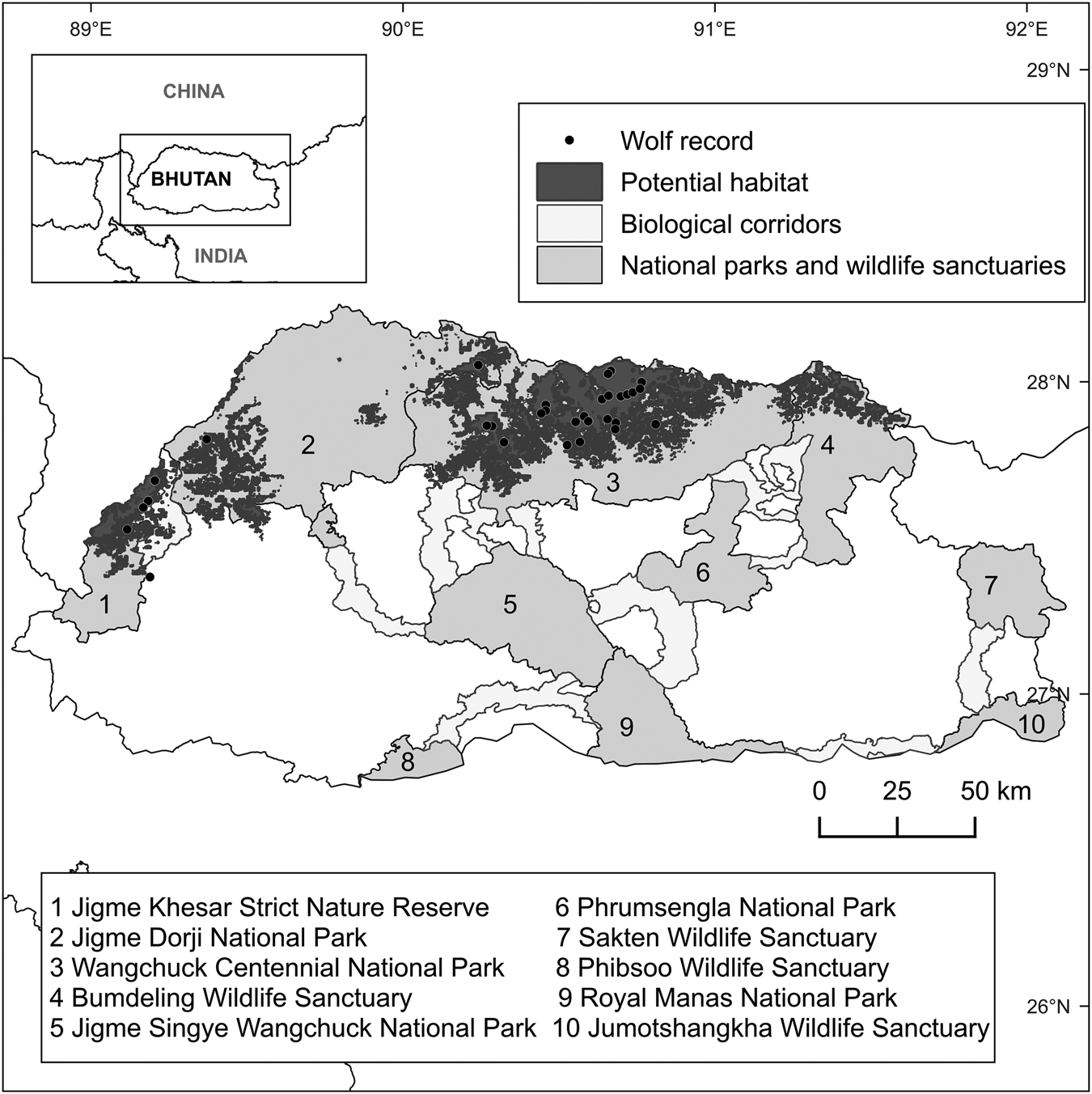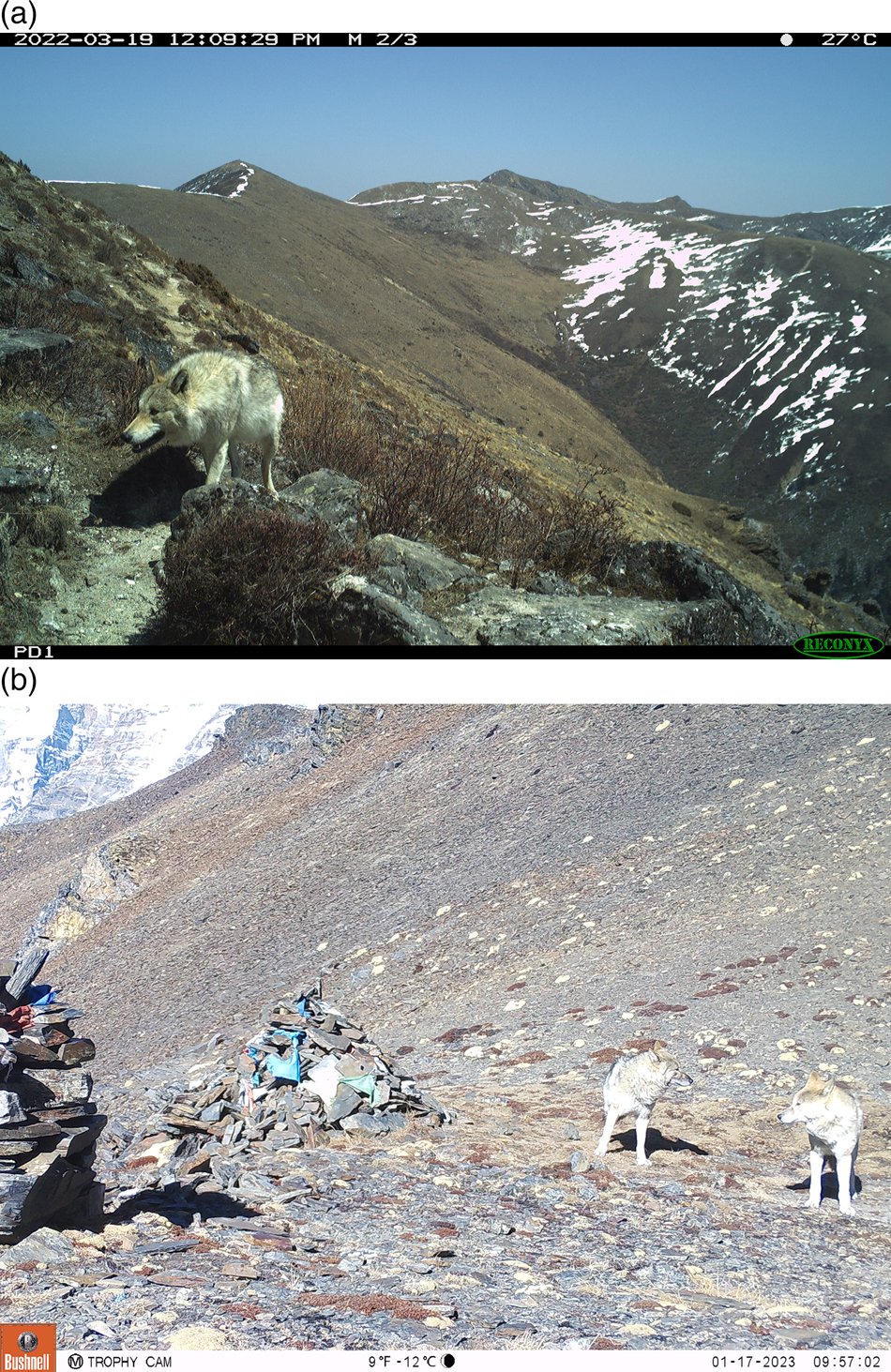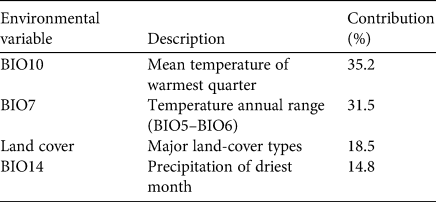The grey wolf Canis lupus is widely distributed across North America, Europe and Asia, yet faces extirpation in some locations, resulting in a distribution restricted to wilderness and remote areas (Boitani et al., Reference Boitani, Philips and Jhala2023). A subspecies of the grey wolf, Canis lupus chanco, known as the Himalayan or Tibetan wolf, inhabits the Himalayas and Tibetan Plateau, and possesses unique genetic adaptations to high-altitude habitats (Werhahn et al., Reference Werhahn, Senn, Ghazali, Karmacharya, Sherchan and Joshi2018; Joshi et al., Reference Joshi, Lyngdoh, Singh, Sharma, Kumar and Prakash2020). Categorized as Vulnerable on the IUCN Red List, it has been estimated there are < 4,000 mature individuals, with a projected continuous decline (Werhahn et al., Reference Werhahn, Hennelly, Lyngdoh, Habib, Viranta and Shrotriya2023). Although the wolves in Bhutan are most likely of the Himalayan subspecies, this has not yet been confirmed.
Little is known about the Himalayan wolf. It occurs in the upper trans-Himalayan region of India, Nepal, the Tibetan plateau and northern Bhutan. In Nepal, the wolf is highly threatened, with < 50 mature individuals recorded, and it is categorized nationally as Critically Endangered (Jnawali et al., Reference Jnawali, Baral, Lee, Acharya, Upadhyay and Pandey2011). In Bhutan, the Himalayan wolf is rare and has been recorded mainly in the high alpine areas of Wangchuck Centennial and Jigme Dorji National Parks and Jigme Khesar Strict Nature Reserve. These records have been consistently associated with instances of livestock depredation (Wangchuk, Reference Wangchuk, Richard and Hoffmann2004).
We compiled records of the wolf in Bhutan from bycatch in a snow leopard Panthera uncia survey during 2022–2023, which covered the northern protected areas and territorial forest divisions at elevations of 3,400–5,200 m (NCD, 2023; Plate 1). The survey area was divided into a 2 × 2 km grid, with a camera-trap station installed in each grid cell, at a location with high probability of snow leopard detection. Each camera-trap station consisted of two cameras, facing each other, to capture both flanks of passing animals. From August 2022 to January 2023, camera-trap stations were deployed across 310 locations. Additionally, we added one wolf record from a nationwide tiger Panthera tigris survey conducted during 2021–2022 and one from a survey for Pallas's cat Otocolobus manul in Jigme Dorji National Park in 2022.
To identify potential wolf habitats across Bhutan, we conducted habitat suitability modelling utilizing MaxEnt 3.4.0 (Philips et al., Reference Philips, Anderson and Schapire2006; Supplementary Material 1). Prior to modelling, we checked for spatial autocorrelation amongst the records, retaining only one point per 1 × 1 km grid cell across the study area (Lham et al., Reference Lham, Cozzi, Sommer, Thinley, Wangchuk, Wangchuk and Ozgul2021). A default MaxEnt model was implemented containing variables that included 19 bioclimatic variables, slope, aspect, elevation and land cover (see Supplementary Material 1 for details). We subsequently excluded variables contributing < 1% to the model (Gong et al., Reference Gong, Gao, Duan, Ge and Wei2023). We then assessed the remaining variables for multicollinearity using the vifcor function, with a correlation threshold of 0.75, in the package usdm (Naimi et al., Reference Naimi, Hamm, Groen, Skidmore and Toxopeus2014) in R 4.3.1 (R Development Core Team, 2023).
We obtained 32 wolf presence points: 25 in Wangchuck Centennial National Park, four in Paro Forest Division, two in Jigme Dorji National Park and one in Jigme Khesar Strict Nature Reserve. From the nationwide snow leopard survey, the relative abundance index (calculated as the number of captures divided by the total sampling effort in days multiplied by 100) of wolves was 0.22, and the naïve occupancy (calculated as the number of camera-trap locations at which we detected wolves divided by the total number of camera-trap locations) was 0.1. The number of individuals captured per independent event was 1–4. The altitudinal range of grey wolf presence was 4,281–5,090 m. The majority of wolf records occurred in alpine meadows (18 of 32), followed by juniper forests (6), rocky outcrops (3), scrubland (3), and ridge (1) and screed slopes (1). Amongst the camera stations, those strategically placed on ridgelines (13 of 32) recorded the highest number of wolf occurrences, followed by those on trails (11) and at the base of cliffs and valley bottoms (4 each). After checking for spatial autocorrelation, we used 31 location points for the MaxEnt model. The model demonstrated a high discriminatory power (area under curve = 0.970), estimating 2,431 km2 of potential habitat in Bhutan (Fig. 1). The mean temperature of the warmest quarter (BIO10) was the most influential variable (Table 1).

Fig. 1 Himalayan wolf Canis lupus chanco records in Bhutan, potential habitat for the wolf modelled with MaxEnt, and national parks and wildlife sanctuaries and the biological corridors connecting them.

Plate 1 (a) A Himalayan wolf Canis lupus chanco camera-trapped in Paro Forest Division in western Bhutan (elevation 4,557 m). (b) Two Himalayan wolves photographed at a high altitude pass between Soe and Lingzhi region of Jigme Dorji National Park (elevation 4,882 m).
Table 1 Relative contributions of four environmental variables to the model of potential habitat for the Himalayan wolf Canis lupus chanco in Bhutan (Fig. 1) using MaxEnt. We executed a full model with all 23 variables, and variables contributing < 1% were excluded from the final model.

There was a greater number of wolf records from Wangchuck Centennial National Park than in other locations. Despite extensive coverage in the nationwide snow leopard survey and reportedly having a high density of blue sheep Pseudois nayaur, which is a preferred wild prey for wolves in Bhutan, there were fewer wolf records in Jigme Dorji National Park. There were no wolf records in Bumdeling Wildlife Sanctuary in the east, although the MaxEnt model predicts the presence of suitable habitat in the area. Discrepancies in prediction of suitable habitat by MaxEnt may arise if there are no records from particular regions or if ecological factors, such as prey availability, are not included in the model. Further research is required to identify key ecological variables for a detailed fine-scale habitat analysis in areas of potential habitat (Červinka et al., Reference Červinka, Šálek, Padyšáková and Šmilauer2013; Rich et al., Reference Rich, Miller, Robinson, McNutt and Kelly2017; Wolf & Ripple, Reference Wolf and Ripple2018). Jigme Khesar Strict Nature Reserve is proximal to the Indian state of Sikkim, where there have been wolf sightings (Choudhury, Reference Choudhury2015), and it is possible that wolves move between these areas. Investigating gene flow and connectivity amongst wolf populations in Bhutan and neighbouring regions would provide a better understanding of genetic diversity, population structure and the impacts of barriers on gene flow. Knowledge of these matters is essential for effective conservation strategies, particularly within the broader Himalayan and Tibetan contexts.
In the Himalayas and Tibet, wolves rely on domestic prey as well as on wild prey species (Lyngdoh et al., Reference Lyngdoh, Habib and Shrotriya2020; Shrotriya et al., Reference Shrotriya, Reshamwala, Lyngdoh, Jhala and Habib2022). In Bhutan, blue sheep comprise the main wild prey of the wolf in high-altitude regions, with blue sheep densities relatively higher in western areas and declining towards the east (Lham et al., Reference Lham, Cozzi, Sommer, Thinley, Wangchuk, Wangchuk and Ozgul2021). Other potential prey species include the Himalayan musk deer Moschus chrysogaster, marmot Marmota himalayana, goral Naemorhedus goral and serow Capricornis thar (NCD, 2023). Livestock also comprise a significant proportion of wolf prey, particularly in regions with limited natural prey and suboptimal livestock husbandry, as reported in the higher altitudes of Wangchuck Centennial National Park (Jamtsho & Wangchuk, Reference Jamtsho and Wangchuk2016; Lyngdoh et al., Reference Lyngdoh, Habib and Shrotriya2020). Wolves frequently prey on livestock in the Park, especially adult yaks, resulting in economic losses that are nearly double those attributed to snow leopards and fostering negative attitudes towards wolves and other predators (Jamtsho & Katel, Reference Jamtsho and Katel2019). The absence of compensation for livestock losses increases the risk of persecution of wolves and threatens the long-term persistence of the species in Bhutan. Anecdotal sources describe a near extirpation of the wolf population in some parts of the country, and suggest that local people set fires in denning caves.
We have described the grey wolf distribution in the Bhutan Himalayas for the first time, and our findings suggest a restricted range for the species, in < 7% of the country. The IUCN Red List indicates wolf range in > 50% of Bhutan (Boitani et al., Reference Boitani, Philips and Jhala2023), implying wolves are widespread across northern Bhutan. Our findings will help inform a revision of this assessment. There is a need to examine the dynamics of human–wolf conflict in Bhutan, for designing appropriate intervention strategies to minimize any conflict. A study of wolf diet using techniques such as DNA metabarcoding of scats would facilitate the identification of prey species and the degree of dependence on domestic livestock. In conclusion, to ensure the long-term survival of the Himalayan wolf, further investigation is needed in Bhutan of its distribution, ecology and abundance Himalayan and of the availability of suitable wild prey.
Acknowledgements
We thank the Nature Conservation Division under the Department of Forests and Park Services for allowing us to use the nationwide snow leopard and tiger survey data.
Author contributions
Data analysis: TD; writing: TD with input from all authors.
Conflicts of interest
None.
Ethical standards
This research abided by the Oryx guidelines on ethical standards.
Data availability
The data that support the findings of this study are available from the corresponding author, TD, upon reasonable request.




